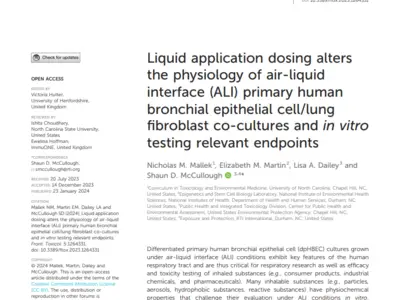A single source solution for specialized needs in respiratory biology and inhalation toxicology
We are fully equipped to provide clients with customized solutions for the evaluation of how inhaled test materials impact the respiratory tract. We accomplish this with an integrated multidisciplinary team of in vitro respiratory biologists, aerosol scientists, exposure engineers, bioinformaticians, computational modelers, and analytical chemists. Drawing on this diversity of expertise, the RTI team designs and executes studies focused on in vivo relevant in vitro cell models, exposure systems and scenarios, and endpoint assays. These studies can be combined with exposure modeling, analytical chemistry, bioinformatics, and in vitro to in vivo extrapolation (IVIVE) to maximize the translation of in vitro study results to human health outcomes.
Comprehensive Solutions for Respiratory Biology and Inhalation Toxicology
Our award-winning experts have been trailblazers in the development and use of respiratory tract NAMs. RTI’s respiratory biologists have more than 15 years of combined experience using air-liquid interface (ALI) respiratory epithelial models for in vitro inhalation toxicology studies. They have also led the field in the development and integration of the most human-relevant methods, including using multi-cellular in vitro respiratory tract models in regulatory studies and decision making; analyzing specific cell type from complex ALI models; incorporating population diversity into in vitro studies; determining mechanisms of action; and the characterization of core assays and sources of ALI model variability.
We offer our clients a full range of human-relevant, in vitro respiratory tract modeling for toxicity evaluation, efficacy assessment, and the development and characterization of new or modified in vitro model systems and assays.
Customized Exposure Systems for Unique Inhalation Scenarios
Our capabilities include:
In vitro exposures
- Exposing differentiated primary human respiratory epithelial models to test materials while maintaining ALI conditions.
- Conducting acute and repeated exposure studies.
- Conducting exposures to e-cigarette aerosols.
- Conducting exposures to experimental aerosols.
- Developing custom exposure systems to address specialized test material exposures and scenarios.
- Quantifying test article deposition, uptake, and transport.
In vitro respiratory systems and assays
- Using commercial or in-house ALI-differentiated 3D epithelial models, and donor-matched co-culture models of different regions of the respiratory tract.
- Using respiratory cell lines (e.g., 16HBE, A549, BEAS-2B, H441, IMR90) for screening.
- Extended duration ALI culture maintenance for evaluating repeated exposures and long-term post-exposure outcomes.
- Measuring cytotoxicity resulting from experimental exposures.
- Measuring epithelial barrier integrity using trans-epithelial electrical resistance (TEER).
- Evaluating permeability of the epithelial barrier to small and large molecules.
- Quantifying the release of inflammatory cytokines, growth factors, and other soluble mediators in single- or multiplex enzyme-linked immunosorbent assays (ELISAs).
- Mucus secretion.
- Measuring ciliary beat frequency (CBF) and percent active ciliated surface area.
- Monitoring gene expression by single- or multi-plex quantitative polymerase chain reaction (qPCR), RNA sequencing, or immunodetection (ELISA and immunoblotting).
- Histology using conventional staining (e.g., hematoxylin and eosin, and Alcian blue/PAS) and immunofluorescence.
- Live cell imaging.
Exposure monitoring, dosimetry, and bioinformatics
- Personal and ambient exposure monitoring and characterization to link real-world and in vitro exposures.
- Deposition (e.g., Multiple-Path Particle Dosimetry (MPPD)) and reverse dosimetry modeling.
- Mass spectrometry and gas chromatography-based analytical chemistry approaches for test article and deposition analysis.
- Benchmark dose (BMD) modeling.
- Quantitative in vitro to in vivo extrapolation (qIVIVE).









